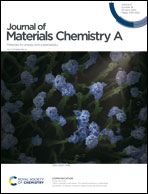Photothermally induced in situ double emulsion separation by a carbon nanotube/poly(N-isopropylacrylamide) modified membrane with superwetting properties†
Abstract
The use of superwetting materials has been regarded as a satisfactory approach to treat simple oil/water emulsions in recent years. However, they are still incapable of handling double emulsions with a multilayer structure. Here, we coated carbon nanotubes (CNTs) and poly(N-isopropylacrylamide) (PNIPAAm) on a poly(vinylidene fluoride) membrane, realizing photothermally induced in situ separation of double emulsions (oil-in-water-in-oil emulsions or water-in-oil-in-water emulsions) with high separation efficiency. By integrating the photo-thermal conversion properties of CNTs and the thermal isomerization properties of PNIPAAm, reversible photothermally controlled wettability transition properties were achieved. The material exhibits high hydrophobicity with a ∼145° water contact angle (WCA) under IR, and exhibits superhydrophilicity with ∼10.0° WCA without IR. Importantly, the CNT dominated liquid evaporation under IR could ensure membrane anti-pollution and permeability, thus realizing in situ separation. Theoretical calculation indicates the significance of the hydrogen bond during the photothermal response. As far as we know, this facile strategy is the first to realize in situ double emulsion separation, and shows guiding significance in smart interfacial design as well as intelligent separation applications.



 Please wait while we load your content...
Please wait while we load your content...